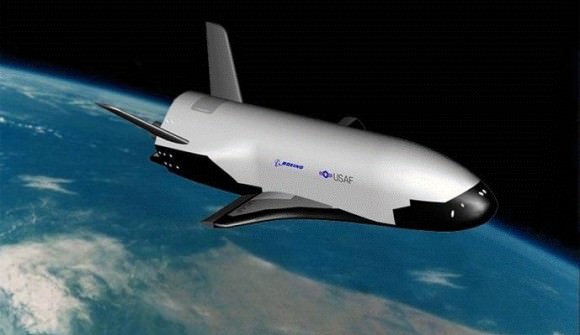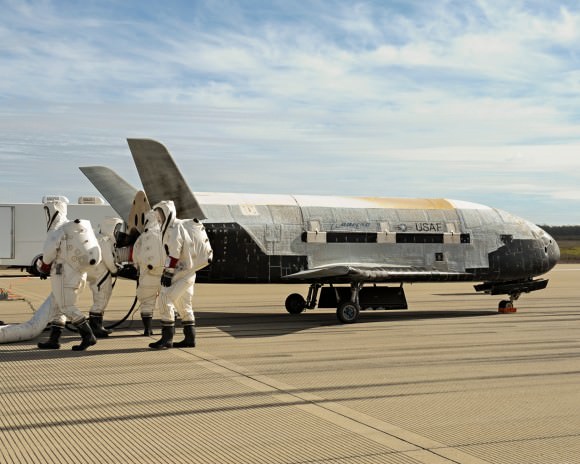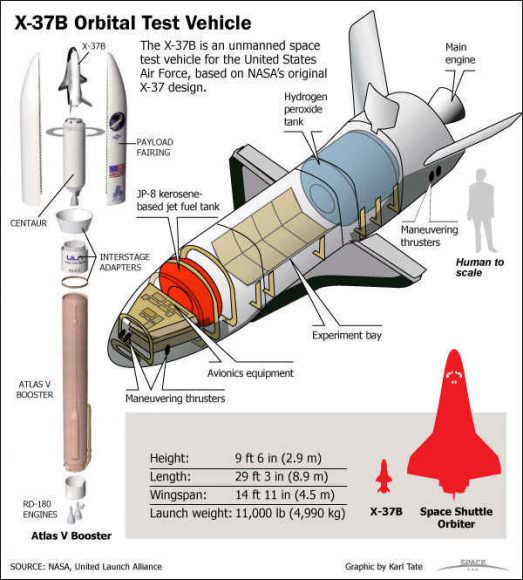For years now, the program to develop the X-37B spacecraft has been shrouded in secrecy. Originally intended as part of a NASA project to develop a reusable unmanned spacecraft, this Boeing-designed spaceplane was taken over by the Department of Defense in 2004. And while it has been successfully tested on multiple occasions, there remain some unanswered questions as to its intended purpose and what has been taking place during these flights.
This, predictably, has lead to all kinds of rumors and speculation, with some suggesting that it could be a spy plane while others think that it is intended to deliver space-based weapons. It’s latest mission – which was dubbed OTV-4 (Orbital Test Vehicle-4) – has been especially clandestine. And after nearly a year in orbit, it remains unclear what the X37B has been doing up there all this time.
The mission began atop a Atlas V rocket which launched from Cape Canaveral Air Force Station on May 20th, 2015. As the second flight of the second X-37B vehicle, the stated purpose of mission was to test a Hall-effect thruster (HET) – a special type of ion thruster that NASA hopes to use on future satellites. The mission had the additional purposes of testing various materials in space for NASA, as well as experimental propulsion system developed by the US Air Force.

Sounds straightforward enough, doesn’t it? But here is where the clandestine nature of things kicks in. Originally, the mission was expected to last about 200 days. But as of the penning of this article, the vehicle is going on 365 days in orbit, and no one is quite sure why or what it is doing up there. While the duration of OTV missions have been secret in the past, as well as the location of their landings, this prolonged stay in orbit is leading to more conjecture about the X-37Bs true purpose.
For instance, if the X-37Bs primary purpose is to test reusable space technologies, then it would make sense to land it before long. In this case, the key aspects of the mission would come down to the Air Force testing their ability to deploy and retrieve the spacecraft, as well as its ability to deliver scientific packages to orbit. This is certainly in keeping with the US Air Force’s fact sheet on the X-37B, which sates that:
“The primary objectives of the X-37B are twofold: reusable spacecraft technologies for America’s future in space and operating experiments which can be returned to, and examined, on Earth… Technologies being tested in the program include advanced guidance, navigation and control; thermal protection systems; avionics; high-temperature structures and seals; conformal reusable insulation, lightweight electromechanical flight systems; and autonomous orbital flight, re-entry and landing.”
However, these aims seems incongruous will all the secrecy that surrounds the X-37B program, which is something one expects instead when dealing with the development of weapons systems. The long-terms stays in orbit also don’t appear to be in keeping with this, as these would only prove useful if the intended spacecraft was meant to act as a satellite (i.e. remain in orbit for extended periods of time to collect information).

As a result, it has been widely speculated in the past few years that the true purpose of the X-37B is to act as a spy plane. As Tom Burghardt commented in his 2010 article, “The Militarization of Outer Space: The Pentagon’s ‘Space Warriors’“, the development of the X-37B is part of the US Air Force’s stated intention of maintaining “space superiority”:
“Now the Defense Department wants to up the stakes with new, destabilizing weapons systems that will transform low- and high-earth orbit into another “battlespace,” pouring billions into programs to achieve what Air Force Space Command (AFSPC) has long dreamed of: “space dominance. Pentagon space warriors fully intend to field a robust anti-satellite (ASAT) capability that can disable, damage or destroy the satellites of other nations, all for “defensive” purposes, mind you.”
This was followed up in 2012 with allegations that the X-37B was spying on the Chinese Tiangong-1 space station module. These claims were naturally denied by the US Air Force, which indicated that the orbits conducted by the test flight did not allow for any opportunities to conduct surveillance. This was backed up by space journalist and analyst Jim Oberg, who said in an interview with the BBC, “They are in orbits which cross the equator about 90 degrees apart. They crisscross each others’ paths at thousands of meters per second. Any observation from one to the other is impossible.”
Others have gone on record as stating that there is nothing particularly telling or alarming about the OTV missions, and that they are likely just the result of the USAF wanting to attempting to test the full capabilities of this new spacecraft. As Joan Johnson-Freese, a professor of national security affairs at the U.S. Naval War College in Newport, Rhode Island, recently told Space.com:
“While no more specifics have been offered about the X-37B by the Air Force since it began flying the orbital technology test bed in 2010, the overall mission seems clear: Lengthy missions allow time for seeing what such a vehicle has to offer in terms of capabilities. The military likes to have lots of arrows in its quiver.”

Nevertheless, the possibility that the X37B supports space-based espionage efforts remains a popular idea. For instance, Brian Weeden – a former air force officer and current technical adviser to the Secure World Foundation – has stated that he thinks the X-37B’s mission is to test reconnaissance and spy sensors, particularly how they hold up against radiation and other hazards of orbit.
The possibility of it being used to capture satellites is also an enduring one. In 2014, Alan Hulas of Guardian stated, “The mystery of the plane centers around the purpose of an interior cavity,” he wrote, “about the size of a truck bed and much too cozy for a human to live in for 674 days, the duration of its latest mission. The main theories suggest that the plane carries sensors and spy equipment, satellites or even weaponry.”
Whatever the true purpose, the reactions towards the X-37B and the levels of secrecy surrounding it are not atypical. Whenever the issue of militarizing space emerges, it triggers fears about the prospect of a “space-weapons race”. And since the Outer Space Treaty placed no bans on stationing conventional weapons in orbit, nor the stationing of spy satellites therein, there are no legal barriers to doing this.
Could the 21st century be a time where the US, Russia, China, and other major space players enter onto an arms race in space? Only time will tell. In the meantime, it might not be a bad idea to update the terms of the Outer Space Treaty and include some articles about secret spy spaceplanes!


With it sitting up there that long doing nothing much I’m sure I’m not the first to wonder if it is not that they don’t want to bring it home but that they can’t? Software glitch? Communications problems? Widget broken?
Could be. There are few in the armed services that wouldn’t rather appear conspiring than incompetent.
I heard they got nailed cause they were still running QuickTime…
haha, that’s low 🙂
Unless they are playing chicken, or bluffing the international community (*cough* Russia *cough* China *cough*), there is no reason to keep it quiet unless the reason(s) isn’t exactly above board. A legitimate exception that I can think of would be the testing of propulsion systems’ efficacy, durability and longevity. While doing that, they could also collect a good large, long-term sample of data on radiation dose and dose rates coming in from all directions, testing new electronic designs for durability and longevity in radiation environments, etc., in different orbits. Stuff that would be a generation or two away from what’s already in the ISS. That is all universally applicable technological testing and advancement that we would want to keep to ourselves for a little while, only sharing some of it with other gov’t agencies, like NASA, eventually. More likely, it is keeping an eye on foreign satellites and/or testing next-gen imaging and range-finding techniques for surface surveillance.
Or, it could be providing a detailed 3D orbital map of all spacejunk down to 1mm particle sizes…that would be awesome and very useful technology…maybe it’s shooting it all down? Redirecting it to foreign satellites? 🙂
Actually, according to a 2012 post on this site, the USAF “Rapid Capabilities Office” runs this program for DARPA…perhaps it is some sort of active defense weapon that can spring into action quickly (if already in orbit) and knock out satellites or other orbiting weapons platforms or help provide guidance for ground-based or air-based weapon systems…bunch of crazy possibilities…
I bet Dick Hoagland knows what they’re doing… Likely something concerning Earth’s Hyperdimensional Vortex….. >.<
I quit my office-job and now I am getting paid 96usd hourly. How? I work-over internet!. My old work was making me miserable, so I was forced to try-sometthing different. Two years after…I can say my lifee is changed-completely for the better! Check it out what i do….i76
=== http://www.PayAbility70.com
As I have speculated before, it could be an emergency restroom for space fairers stranded in orbit without those facilities.